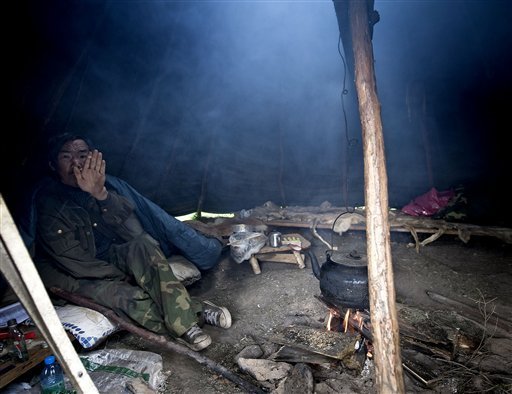 |
|
|
AP Photo - In this photo taken on Aug. 27, 2009, a man from the Ewenki ethnic group is seen resting in a tent inside a forest park in Genhe, Inner Mongolia, China. Resettlement by China's government has brought members of the small Ewenki ethnic group from the steppe to the city, housing them in a newly built estate but inevitably changing their traditions.
|
|
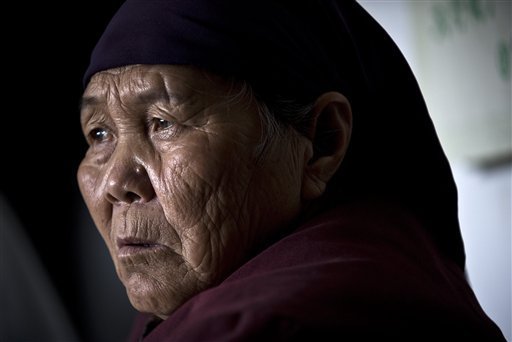 |
|
|
Andy Wong - In this
photo taken Aug. 27,
2009, An Tabu, an Ewenki
ethnic woman, sits
inside a
Finnish-designed
sloped-roofed wooden
house specially built
for the resettled Ewenki
ethnic people in Genhe,
Inner Mongolia, China.
|
|
 |
|
|
Andy Wong - In this
photo taken on Aug. 27,
2009, a man washes
clothes outside the
Finnish-designed gated
community of spacious
sloped-roofed wooden
houses for the resettled
Ewenki ethnic people in
Genhe, Inner Mongolia,
China.
|
|
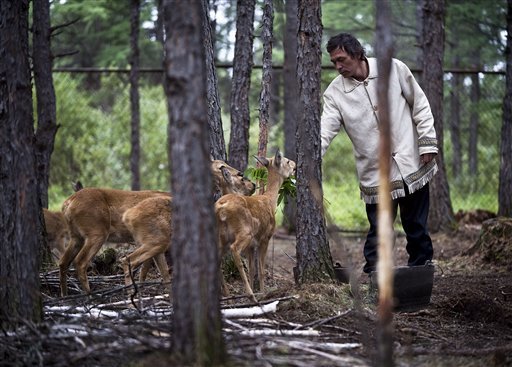 |
|
|
Andy Wong - In this
photo taken Aug. 27,
2009, Gu Gejun feeds his
deer at a forest park in
Genhe, Inner Mongolia,
China.
|
|
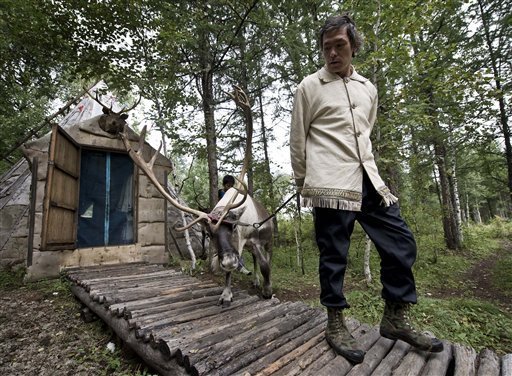 |
|
|
Andy Wong - In this
photo taken Aug. 27,
2009, Gu Gejun leads his
reindeer at a forest
park in Genhe, Inner
Mongolia, China.
|
|
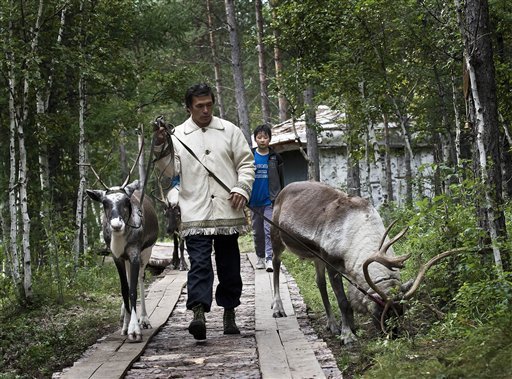 |
|
|
Andy Wong - In this
photo taken Aug. 27,
2009, Gu Gejun walks his
reindeer at a forest
park in Genhe, Inner
Mongolia, China.
|
|
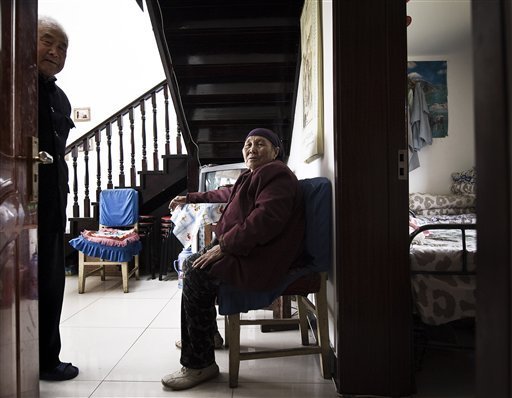 |
|
|
Andy Wong - In this
photo taken Aug. 27,
2009, An Tabu, right, an
Ewenki ethnic woman,
sits inside a
Finnish-designed
sloped-roofed wooden
house specially built
for the resettled Ewenki
ethnic people in Genhe,
Inner Mongolia, China.
|
|
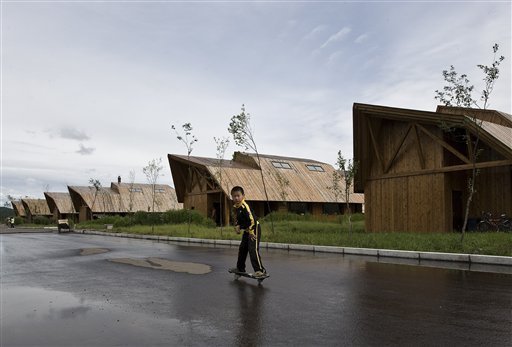 |
|
|
Andy Wong - In this
photo taken Aug. 27,
2009, a boy on a
skateboard passes by
homes in the
Finnish-designed gated
community for resettled
Ewenki ethnic people in
Genhe, Inner Mongolia,
China.
|
|
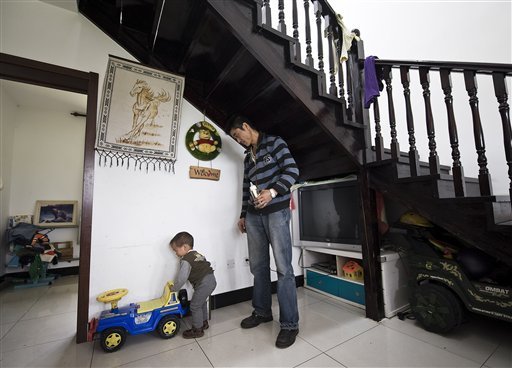 |
|
|
Andy Wong - In this
photo taken Aug. 27,
2009, an Ewenki ethnic
man with his child is
shown in a
Finnish-designed home in
the gated community for
resettled Ewenki ethnic
people in Genhe, Inner
Mongolia, China.
|
GENHE CITY, China -- Herding reindeer and hunting bears and boars in the forests on Siberia's fringe was Gu Gejun's life. Now his rifle has been confiscated, and the only reindeer he herds are in an urban tourist park.
China has moved most of the small Ewenki ethnic group from the steppe to the city, giving its members better access to medical services, education and jobs but, inevitably, changing their traditions.
They are among more than 700,000 nomadic herders - mostly Tibetans, Mongols and Kazaks in western China - the government has resettled since 2000.
About 60 Ewenki families live here in a Finnish-designed gated community of spacious sloped-roof wooden homes in orderly rows. They have televisions and washing machines. Across the street a teepee-like tent houses an exhibit on how the Ewenki used to live. Nearby, a dozen reindeer graze in a cleared patch of forest, watched over by Gu, a 37-year-old man with the chiseled looks of a movie star.
"Our lifestyle has been affected, because we Ewenki are born hunters," he said. "From older generations to younger generations we used to live on hunting. It's in our blood."
Gu had to turn over his semiautomatic rifle when he was resettled six years ago. He still remembers the model number engraved on it - 62684 - though he cannot remember the one on his government ID card. "When we go into the mountains and talk about guns we just cry," he said.
The government says resettlement raises living standards and protects the grasslands from overgrazing and desertification. Many living near international borders have been moved for security, as Beijing worries about sabotage, smuggling and illegal border crossing.
The Ewenki (pronounced ehr-when-key) roamed for centuries around southern Siberia in Russia. About 300 years ago, in search of better hunting grounds, some crossed the Greater Hinggan Mountains into China. Today, about 64,000 remain, half in China.
Reindeer were at the center of Ewenki life, providing milk and transport, and they were revered, said An Tabu, 66, as she looked from her house to a newly paved road where kids practiced skateboarding.
Under the resettlement program, An Tabu and 242 others from the Aoluguya branch of the Ewenki moved 200 miles (300 kilometers) to Genhe, a small city of lumber mills and white-tiled buildings, in 2003. The Aoluguya are the last of three groups of Ewenki to be settled.
They brought 700 reindeer, but the herd could not find enough to eat and some died, residents said. Around 30 Ewenki returned to the birch-and-pine-forested mountains, taking the reindeer.
"It's not good here," An Tabu said. "We can't hunt anymore, like I did when I was younger."
Moving to Genhe has given them a chance to thrive in the mainstream of China's booming economy. The price has been the loss of tradition and language, as younger Ewenki learn Chinese to compete.
"After being resettled, their living conditions were improved, but their way of life changed," said Yu Zhixue, an artist who first visited the Ewenki in the 1950s, living in their mountain camps and drinking reindeer milk instead of water. "The fact that they gave their guns to the government was a symbol for the end of an era. Many of the younger generation of the Ewenki now would rather play with computers than go into the mountains and hunt."
Suo Ronghua lived in the mountains until she was seven and sent to school in Mangui. She married a man from China's Han majority whom she met in 1999 at the city's college.
Now 33 and a mother of two, Suo said city life suits her. Her 10-year-old daughter gets taken to school where classes are in Mandarin. She does regret the girl cannot speak Ewenki.
"We are not many people, so many people have married Han Chinese," said Suo, lifting her young baby up and down in the bright airy living room. "It is unfortunate because Ewenki people should protect their traditions."
Their reindeer were collectivized in the early years of communist rule, and their shamanic belief system was outlawed during the radical Cultural Revolution. They have seen their traditional hunting grounds shrink, first as they were moved away from the border during China-Soviet Union tensions and then by logging and poaching by Chinese, who hunted their reindeer for its antlers and penis for Chinese medicine.
By the time resettlement began for the first Ewenki in the 1990s, many were dispirited. Alcoholism rates were high, and assimilation already under way. The government began giving Ewenki welfare payments in the 1980s, and they still get a 400 yuan ($60) subsidy each month. In Genhe, around half have found jobs running small tourism businesses, residents said, and others left to look for work on construction sites.
Dular Osor Chaoke, an Ewenki at the government-backed Chinese Academy of Social Sciences in Beijing, favors integrating with the mainstream and adapting traditions to modern life. The linguist is developing a Roman alphabet for the language and a software program for its use on computers and mobile phones.
"We have to use modernized and high-tech methods to preserve our ethnic languages and ethnic cultures," Dular said, taking out his mobile phone and sending an Ewenki text message to a friend in Inner Mongolia as a demonstration. "This is the only way."







